You’re already familiar with today’s U.S. coins, the penny, nickel, dime, and quarter. But the United States Mint created a whole host of other coins in different denominations before our current system came to be.
Here’s an overview of America’s coins, past, present, and future.
Your complete guide to U.S. coins, from the half-cent to gold coins and everything in between.
The U.S. Mint
The U.S. Mint is where all American coins are made. The Mint was founded over 230 years ago on April 2, 1792.
Though it is headquartered in Washington, D.C., the Mint has historically had multiple coin-producing facilities.
U.S. Mint Locations
The locations shifted through the years, but there are currently four operating facilities under the U.S. Mint:
- Philadelphia
- San Francisco
- West Point
- Denver
With the help of the Federal Reserve Banks, which issues new currency every year, and as a bureau of the Treasury Department, the United States Mints play a vital role in the U.S. economy.
U.S. Mint Facts –
- The Fugio Cent was the very first coin ever struck at the U.S. Mint in 1787. As the first official coin in circulation, the Fugio Cent was also referred to as the Franklin Cent, as it was rumored to have been designed by Benjamin Franklin.
- The first mint was in Philadelphia because it was the capital of the U.S. at the time. Today, Washington D.C. is the headquarters of U.S. Mint operations.
- After his work as treasurer of Pennsylvania under President George Washington, David Rittenhouse became the first U.S. Mint Director. David was also a well-known mathematician, inventor, clockmaker, and astronomer.
- Technically, Fort Knox falls under the U.S. Mint jurisdiction, but it produces no coinage. It’s primarily a gold storage facility, holding an estimated 147 million troy ounces of gold bullion.
- Many people often confuse the U.S. Mint as the printer of paper currency, but that’s the job of the Bureau of Engraving and Printing. The U.S. Mint does not print paper money.
Half Cent
The half-cent was the first coin struck by the U.S. Mint and was produced from 1793-1857.
Coinage valued less than one dollar is referred to as fractional U.S. currency, and the half-cent was the smallest-valued coin produced in the U.S.
Half Cent Variations
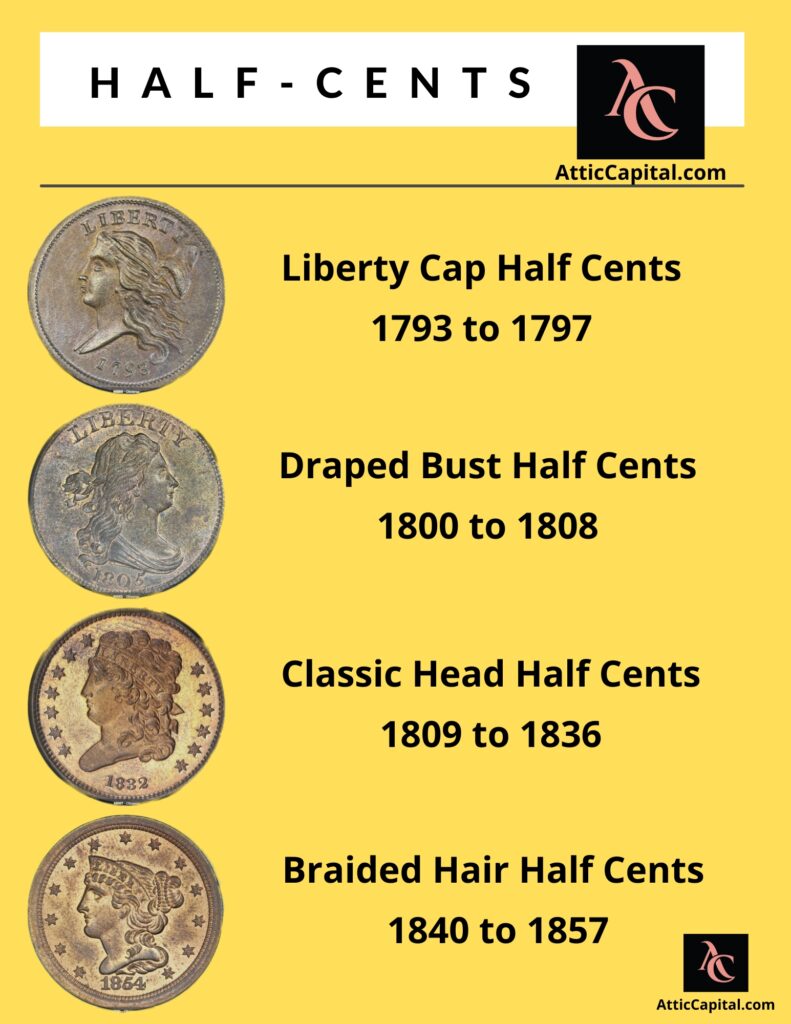
This coin was made in five different designs:
- Liberty Cap Facing Left: Featured a bust of Lady Liberty with a liberty cap. (a historical symbol of freedom from the American Revolution)
- Liberty Cap Facing Right: Featured a similar design with Lady Liberty facing in the opposite direction.
- Draped Bust: Featured another design of the bust of Lady Liberty.
- Classic Head: Featured a portrait of Lady Liberty with long, flowing hair.
- Braided Hair: Featured Lady Liberty with braided hair and a crown.
Half Cent Design
All of these designs featured a wreath on the back. Nearly 8 million were minted, and these coins are incredibly scarce today. Some designs in fine condition are worth $37,500 or more.
None of the half-cent coins have a mint mark. They were all struck at the Philadelphia Mint, with a composition of 100% copper.
Although the designer of the very first half-cent is undetermined, it’s thought to be either Adam Eckfeldt or Joseph Wright.
Half Cent Coin Values
- 1793 Liberty Cap Half Cent, MS66 – $1,000,000
- 1804 Draped Bust Half Cent, MS66 – $27,500
- 1811 Classic Head Half Cent, MS66 – $1,000,000
- 1854 Braided Hair Half Cent, MS67 – $8,000
Half Cent Facts –
- Edge lettering on the original half-cent coin in 1793 noted, “Two hundred for a dollar.”
- Out of the original 35,000 half-cent coins struck in the first year, only about 550 still exist today, with 20 known coins in mint state condition.
- Half-cent coins were the first with Robert Scot’s famous ‘Draped Bust’ design.
- Mintage of the half-cent ended in 1857, but the coin was nearly revived in 1912 by Congress. But the proposed half-cent, along with a three-cent coin, was struck down by the Senate.

Large Cent
The large cent, minted from 1793 to 1857, was the precursor to the modern penny. It was heavy and larger than modern-day quarters.
Like the half-cent, the large cent came in several different designs, all of which were portraits of Lady Liberty.
Rarest Large Cent
The rarest and most valuable is the flowing hair cent with the chain reverse. Only 36,103 were minted in 1793. This particular large cent was almost universally panned.
Large Cent Design
Critics believed the bust of Lady Liberty was notably unattractive. And since the back included a ring of chains, many thought it was a nod to slavery.
The flowing hair cent with chain reverse is unique thanks to its rarity. A remarkably well-preserved coin can be worth up to $500,000. Even poorly preserved coins sell for around $3,000.
Large Cent Values
- 1793 Chain Periods Flowing Hair Large Cent, MS66 – $2.3 Million
- 1793 Chain Flowing Hair Large Cent, MS64+ – $1.5 Million
- 1795 Flowing Hair Large Cent, PCGS VG10 – $1.25 Million


Small Cent Pennies
The small cent was produced in response to the high copper and coin manufacturing prices. These pennies were made from 1856-1958 and came in three different designs:
- Draped Bust Cent (1796-1807)
- Classic Head Cent (1808-1814)
- Coronet Head Cent (1816-1839)
- Braided Hair Cent (1839-1857)
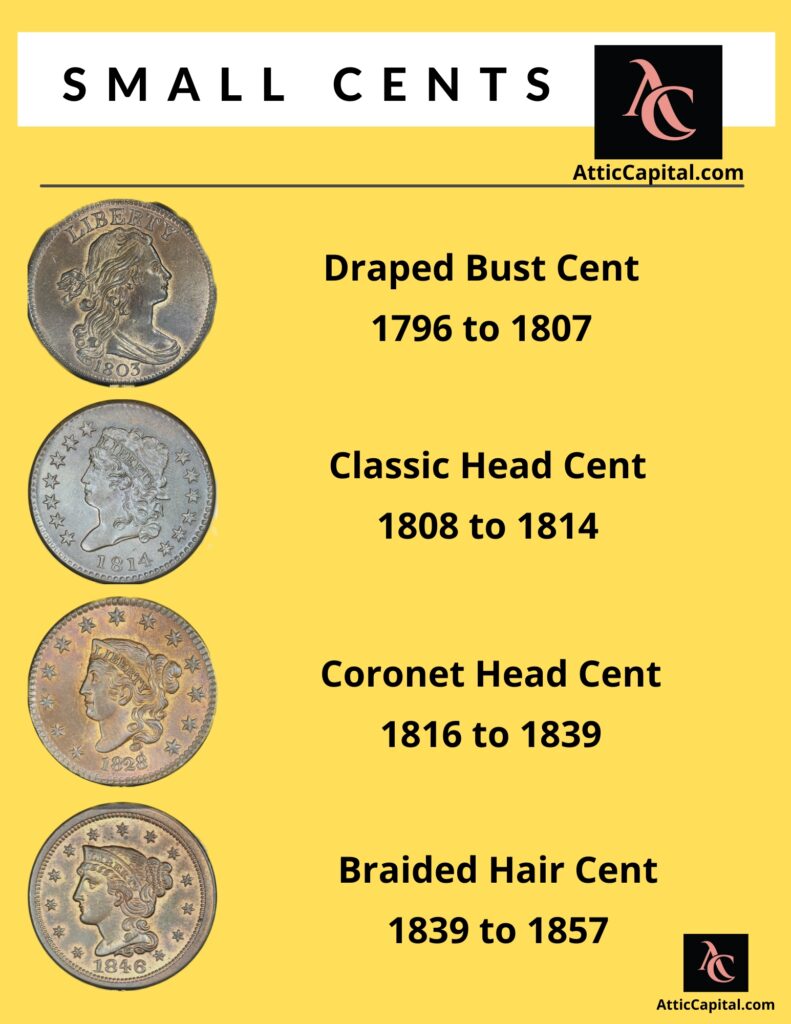
- Flying Eagle (1856-1858): Featured an eagle in flight on the front
- Indian Head (1859-1909): Included a portrait of Lady Liberty wearing a Native American headdress
- Lincoln Wheat Cent (1909-1958): Portrait of Abraham Lincoln, the Lincoln Cent was one of the most heavily-circulated coins ever. The 1944 steel cents are some of the most valuable pennies ever minted and auction prices range over $350,000.
- Lincoln Memorial Cent (1959 to Present) Composed of 97.5% Zinc after 1982, the metal is toxic in large quantities. If a penny is swallowed, the acidic stomach is soluble with the zinc ion and can damage internal organs.

The rarest is the 1856 flying eagle design, as only 2,000 were minted. Many of these are worth up to $30,000 today.
Small Cent Design

Two-Cent Piece
The two-cent piece was a relatively short-lived design, so it’s a favorite for coin collecting. It was only minted from 1864-1872, though there was a unique production run for collectors in 1873.
This coin featured an elaborate shield design on the obverse and a wreath design on the reverse.
Initially, the two-cent piece was popular, but the nickel and the three-cent piece eventually overtook it. Today, two-cent pieces are much more affordable than you would expect.
You can find decently-preserved ones for around $200.
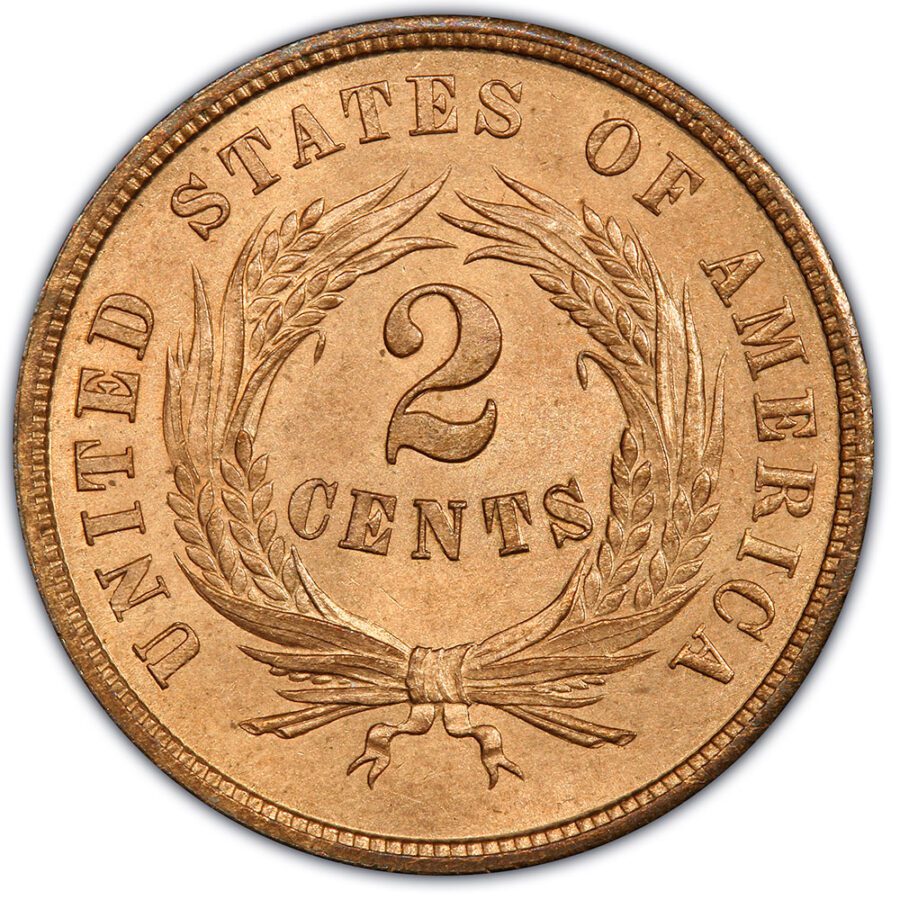
Silver Three-Cent Piece
The silver three-cent piece served an essential historical purpose. In 1851, silver coins had a higher bullion value than face value. As a result, they started to disappear from circulation to be melted down.
The three-cent piece contained 0.75 grams of fine silver, and traditional silver coins contained 0.90 grams.
As a result, the silver three-cent piece had a higher face value than the bullion value, so it stayed in circulation.
It was minted from 1851-1873 and bore an eye-catching shield design within a star. Today, uncirculated coins are often worth around $400.
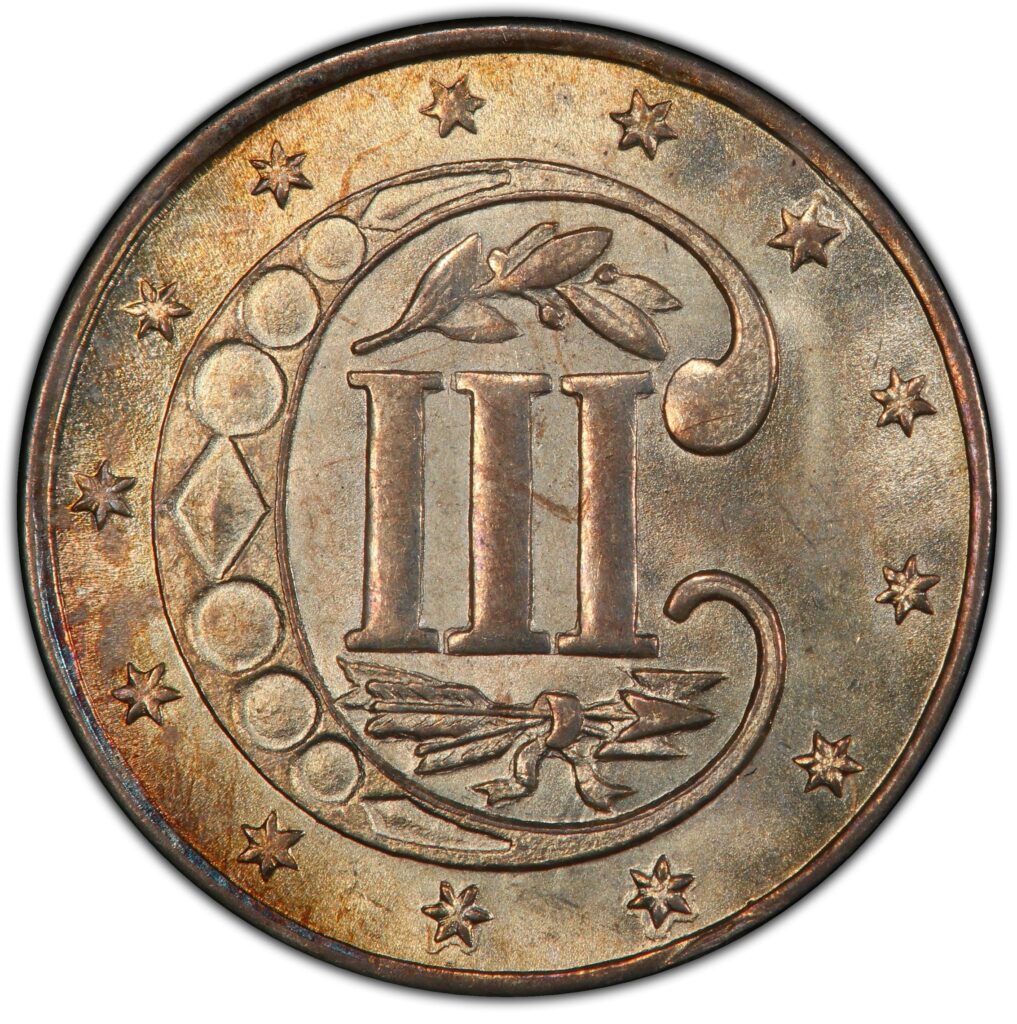
Nickel Three-Cent Piece
The three-cent nickel, minted from 1865 to 1869, was designed to replace the three-cent note.
Thanks to coin hoarding during the Civil War, the U.S. began issuing paper money for better accessibility to currency, so the three-cent pieces were removed from circulation.


Once the five-cent nickel was created in 1866, it became much more popular than the three-cent nickel.
This design featured the Head of Lady Liberty on the front and the Roman numeral III surrounded by a wreath on the back. Today, these rare coins are worth around $100.

Nickels
The nickel is still around today. Before it reached its final form (the Jefferson nickel), it went through a few incarnations:
- Shield Nickel (1866-1883): Featured a shield design on the obverse and the number five ringed with stars and rays on the reverse
- Liberty Head Nickel (1883-1912): Featured a portrait of Lady Liberty on the obverse and the Roman numeral V ringed by a wreath on the reverse
- Buffalo Nickel (1913-1938): Featured a portrait of a Native American on the Obverse and a bison on the reverse

Many of these coins are worth around $200 today. The exact value depends on the year of minting and the coin’s condition.
Nickel Coin Values
- 1866 Shield Five Cent Piece, MS67 – $40,000
- 1886 Liberty Head Nickel, MS67 – $50,000

Half Dimes
This five-cent coin was minted from 1792-1873. Interestingly enough, it was only sometimes called a half-dime.
When it was released, it was called a half disme. “Disme” (pronounced “deem”) is French for “tenth.” Many people ended up pronouncing it as “dime.”
- Bust Half Dime (1792)
- Flowing Hair Half Dime (1794-1795)
- Draped Bust Half Dime (1796-1805)
- Capped Bust Half Dime (1829-1837)
- Liberty Seated Half Dime (1837-1873)
The name stuck even when the Mint released a ten-cent coin.
The half dime came in several designs, and many are still available to collectors today. In most cases, they sell for a few hundred dollars or less.


Dimes
The dime has been minted since 1796, though the U.S. Mint didn’t produce dimes yearly. It was released in several designs, many featuring Lady Liberty.
In its current form, the dime features President Franklin D. Roosevelt on the obverse and a torch, olive, and oak branches on the reverse.
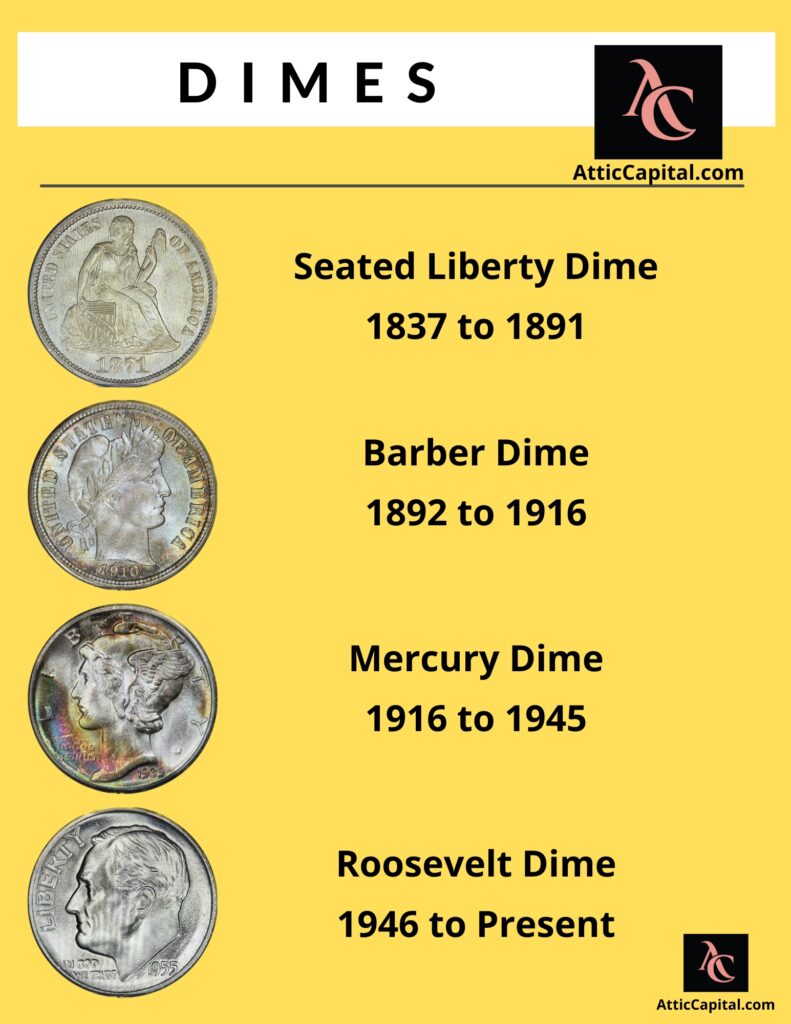
- Draped Bust Dime (1796-1807)
- Capped Bust Dime (1809-1837)
- Liberty Seated Dime (1837-1891)
- Barber Dime (1892-1916)
- Mercury Dime (1916-1945)
- Roosevelt Dime (1946- Present)
Today, older dimes like the Mercury and the Barber dime in fine condition can sell for a few thousand dollars, though a perfect one can fetch tens of thousands.

Twenty-Cent Piece
Because it was so easy to confuse with the quarter, its mintage took a lot of work. This coin was only minted from 1875-1878.

At the time, both coins were of similar size and design. Today, collectors can often find coins in non-perfect condition for less than $100.
Consider PCGS, where nearly every single coin ever minted is documented.
Quarters
The quarter has been minted from 1796 onward. Like most coins on the list, it has been through several historical designs.
The U.S. Mint also continues to periodically change the design for different causes.
- Draped Bust Quarter (1796-1807)
- Capped Bust Quarter (1815-1838)
- Liberty Seated Quarter (1838-1891)
- Barber Quarter (1892-1916)

For instance, you might remember the 50 State quarters of 1999-2008, where each state had its own reverse design. You can find all 50 state quarter proof sets for about $50.
- Standing Liberty Quarter (1916-1930)
- Washington Quarter (1932-1998)
- Washington 50 States Quarters (1999-2008)
- Washington D.C. and U.S. Territories Quarters (2009)

- Washington America the Beautiful Quarters (2010-2021)
- Washington Crossing the Delaware Quarters
- American Women Quarters (2022-2025)
The Mint recently released America the Beautiful quarters and is currently releasing American Women quarters. From 2027-2030, it also plans to release Youth Sports quarters.
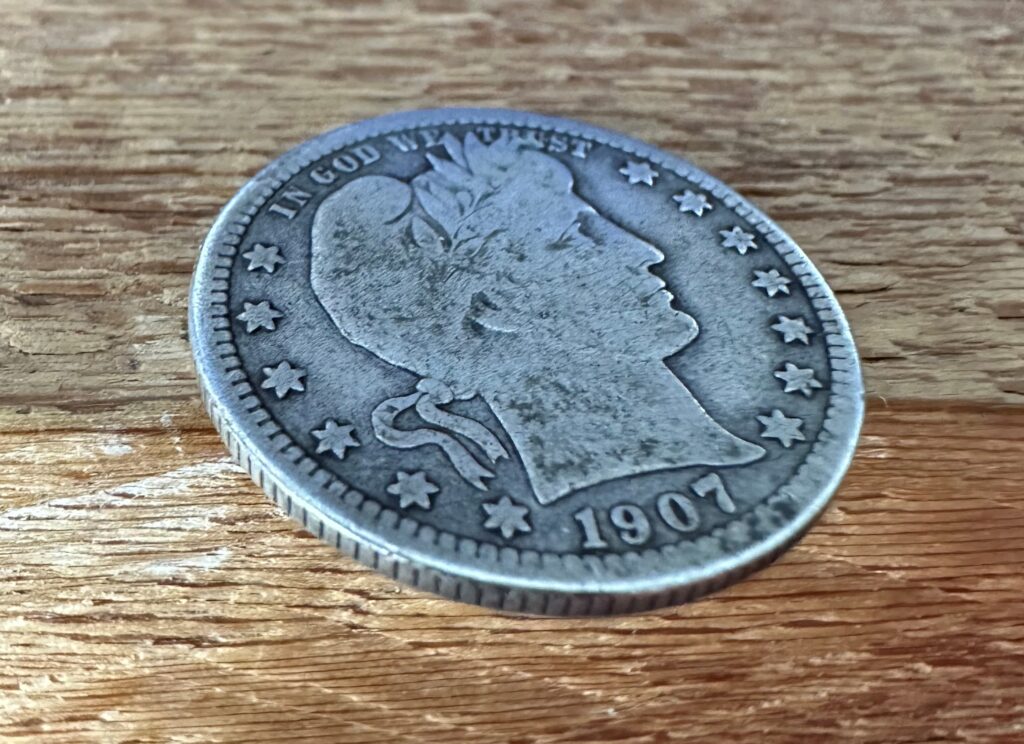

Half-Dollar Coins
The half-dollar is currently the largest and heaviest coin the U.S. Mint produces.
However, you may have noticed that you only see the half-dollar occasionally in general circulation. In their heyday, half-dollars were quite popular for use in casinos.
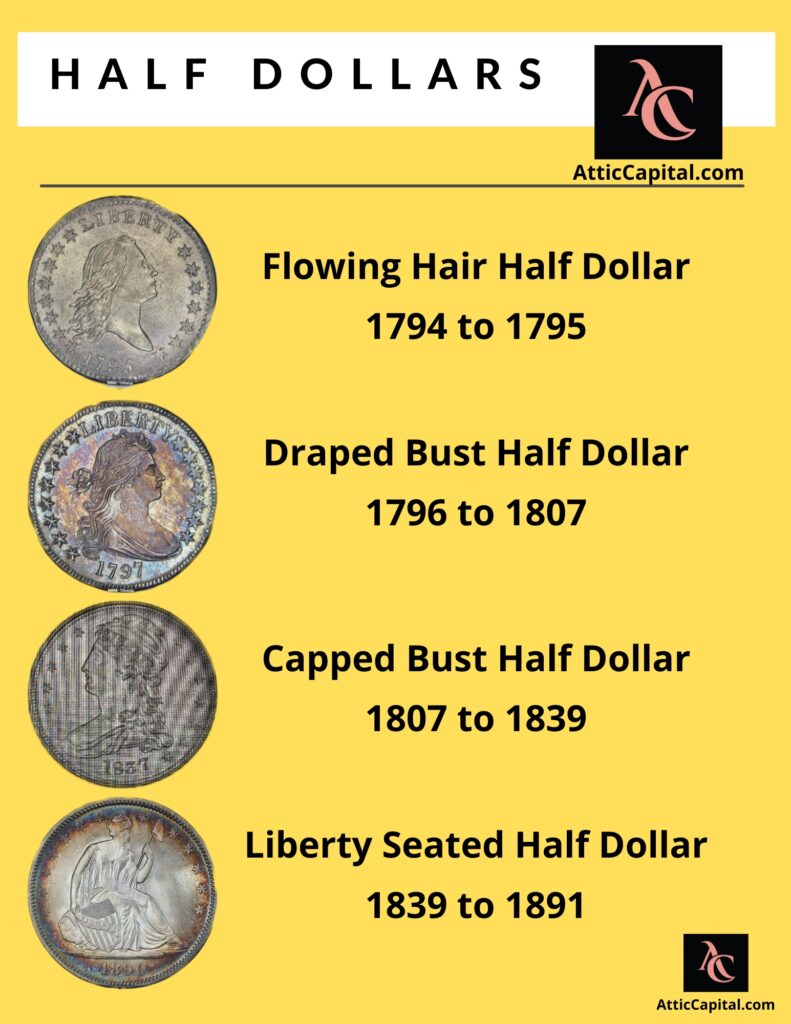
- Flowing Hair Half Dollar (1794-1795)
- Draped Bust Half Dollar (1796-1807)
- Capped Bust Half Dollar (1807-1839)
- Liberty Seated Half Dollar (1839-1891)
But as more casinos have switched to using chips rather than coins, demand has dropped even more.
The Mint still makes Kennedy half-dollars, but they are only for collectors.
If you’d prefer to buy an already-circulated coin, check with your bank or credit union. Most will let you order half-dollar coins through them.

- Barber Half Dollar (1892-1915)
- Walking Liberty Half Dollar (1916-1947)
- Franklin Half Dollar (1948-1963)
- Kennedy Half Dollar (1964-Present)
Half-Dollar Design
Since 1794 when the first half-dollar coin was minted, there have been eight design changes to the coin.
In 1947, John R. Sinnock was selected to design the new half-dollar coin honoring Benjamin Franklin, but Sinnock passed away before the design was completed.
Some controversy surrounded the Franklin half dollar because Benjamin Franklin was avidly opposed to portraits of people on the currency. But the director of the mint, Nellie Tayloe Ross, was a long-time admirer of Franklin.
Others said that Franklin would have opposed the idea of an eagle on the reverse of his coin. Historians noted that Ben Franklin didn’t like the idea of the eagle as the national bird. He insisted the bird was a “scavenger.”
Franklin proposed the wild turkey instead of the eagle for the nation’s official bird, but he was overruled.

Dollar and Silver Dollar Coins
The U.S. Mint has historically created many different dollar coins. In recent years, new dollar coins have yet to be popular.
But consider yourself lucky if you can get your hands on one of the first dollar coins. Silver dollar coins from 1794 and 1795 feature a Lady Liberty design.
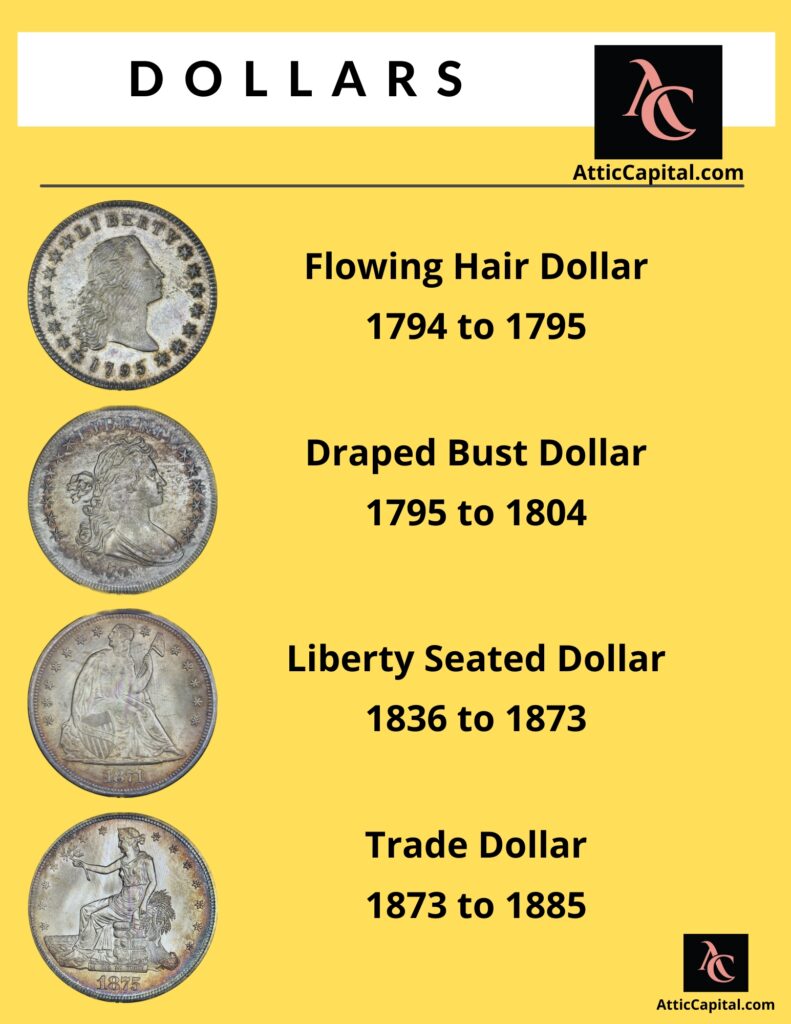
Uncirculated coins will sell for up to $975,000. One in perfect condition can even sell for $6 million or more.
Some more modern (and easier to find) dollar coins include the Peace Dollar, Eisenhower Dollar, Susan B. Anthony Dollar, Presidential Dollar, and Sacagawea Dollar.

Of course, there’s always the great U.S. Silver Eagle coin, containing one troy oz. of .999 purity silver.

U.S. Commemorative Coins
The U.S. Mint does more than make coins for general circulation. It creates unique coins to honor special people and events.
The first commemorative coin was the Columbian half dollar (honoring Christopher Columbus) of 1892. Another significant issue is the George Washington half-dollar.
It was created in 1982 to mark the 250th anniversary of Washington’s birth.
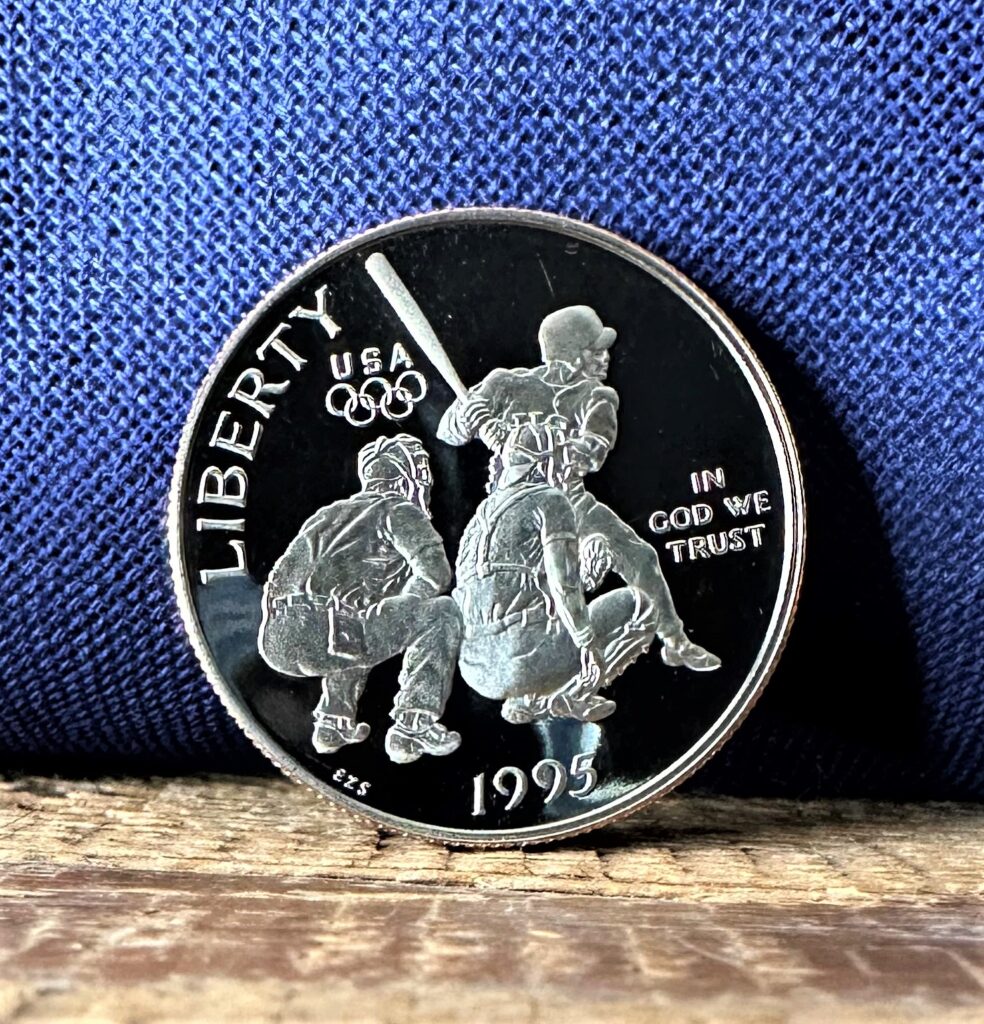
The George Washington Bicentennial Quarter was another commemorative coin on the 200th anniversary of the United States’ independence from England.
In 2019, the U.S. Mint began the American Innovation Dollars program in honor of innovators for each of the 50 states. The series will run through 2032.
Before that, the U.S. Territories quarters were issued to honor the District of Columbia and other U.S. territories.
Commemorative coins are scarce, as they have much smaller mintages than circulation coins. Adding one to a collection can be an exciting event for a numismatic enthusiast.
Prices for commemorative coins vary depending on the size and composition of the coin.
Official information and news on commemorative coins are released on the U.S. Mint website.

U.S. Gold Coins
Even though they are not circulating coins, U.S. gold coins are known for their unmatched artistic craftsmanship.
They were minted in small batches and only made from 1795-1933. Many have been melted down over the years, so they are exceedingly rare. Coins in perfect condition can sell for $28,000 or more.
Suppose you’re interested in modern coins made of precious metal. In that case, the American Eagle Platinum Bullion coin and the American Eagle Palladium Bullion coin (also available in a proof finish for coin collectors) are two others.
For collectors, one of my favorite coins is the quarter eagle, a two hundred and fifty cent gold coin minted for over a hundred years at various U.S. Mints.
A few other gold coins offered by the U.S. Mint –
- American Eagle One Ounce Gold Coin – $2,770
- American Buffalo One Ounce Gold Proof Coin – $2,840
- American Eagle One-Tenth Ounce Gold Proof Coin – $325
- American Liberty One Ounce 225th Anniversary Gold Coin – $2,865

Discovering the World of U.S. Coins
As you can see, the U.S. Mint’s rich history includes countless coins, many of which feature beautiful artistic designs.
If you’re new to the world of numismatics, just learning about U.S. coinage can be fascinating. And if you’re starting or expanding a collection, hunting for some of these historic coins can be a real adventure.
There’s Much More To Learn About U.S. Coins –
So Far, We Know –
- Each U.S. Coin denomination and the different types throughout US history.
- Every different type of U.S. coin and the years they were produced by the Mint.
- U.S. gold coins are not circulation currency, but highly collected and extremely desirable coins for numismatics and investors.
But There’s More U.S. Coin Facts –
- American Eagle coins are not just minted in silver. Gold, platinum, and palladium coins are also sold by the U.S. Mint in various sizes.
- Bullion coins are sold by the U.S. Mint as investment-grade coins through distributors and dealers who mark the coins for sale based on current bullion prices, with an additional markup to cover overhead costs.
- Proof sets can also be purchased directly from the U.S. Mint. Proof sets contain one coin of each denomination from a certain year of mintage with mirror-like backgrounds and sharp relief.
- The average “lifespan” for a typical U.S. Penny is roughly 40 years.
- The practice of reeded edges on coins originated from Isaac Newton as a way to prevent counterfeiting by clipping the edge of coins to extract tiny pieces and repurpose the metal.
- It’s estimated there are over $10 billion worth of U.S. Coins sitting in homes across the country.
- The U.S. Mint produces more coinage than any other country in the world. It also minted coins for other foreign governments until it stopped the practice in 1984.
More U.S. Coin Collecting Resources and Links –
- I want to sell my coins online, where should I go?
- How much are my rare coins worth? Here’s a simple guide.

